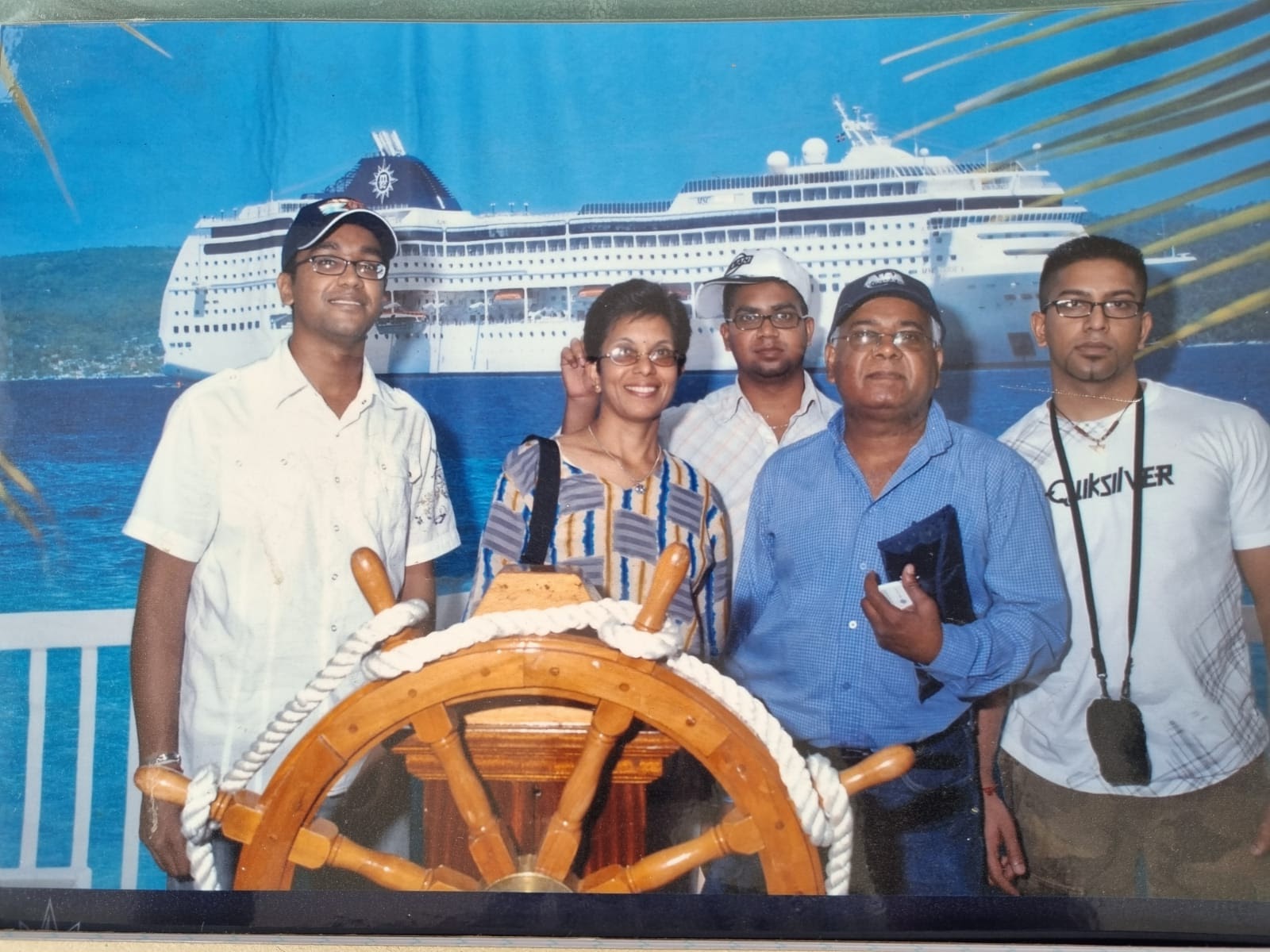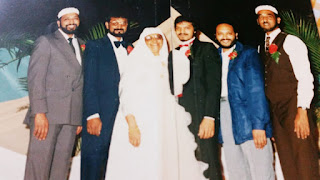K C MOONISAMI FAMILY HISTORY – AN INTEGRATION OF INDIAN AND SCOTTISH ANCESTORS
INTRODUCTION:
On Saturday, February 24, 2024, the last surviving sibling of the pioneer K C Moonisami Family of Gazard Road, Ottawa, passed away at the age of 73. Dharmalingam "Reggie" Moonisami had survived four other brothers and two sisters. A year or two before his passing, I had interacted with him about the history of the K C Moonisami Family. His funeral took place at the Clare Estate Crematorium in Durban on Monday, February 26. Large numbers of family members, business associates, friends, golfing mates and some old-time residents of Ottawa attended the ceremony to bid Reggie their last respects.
As a tribute to Reggie and his extended family, I am today (Feb 27 2024), publishing the article about the well-known pioneer K C Moonisami Family.
BY SUBRY GOVENDER
One of the pioneer families that played a significant role in the social, community and sporting activities of our village of Ottawa since the very early days was the Moonisami clan of Gazard Road in the Uplands area.
Gazard Road was formerly known as Park Lane.
The Moonisami family became well-known in Ottawa mainly through the football and community activities of the eldest son, K C George Moonisami, and his brothers – Rathanum, known as Sunny, Thangavelu, known as Sam, Valiatham, known as Veloo, and Dharmalingam, known as Reggie.
K C George was a top striker in the Ottawa Football Club team for more than two decades when playing in the Verulam Football Association. He was selected to represent Verulam in inter-district tournaments and also played for the Rangers Football Club in Durban. Rangers was later transformed into the Manning Rangers F C that played in the South African Soccer Federation Professional League (SASFPL).
His brothers – Sunny and Reggie – also played for the Ottawa Football Club. In the 1980s and 1990s Reggie teamed up with another local soccer player and activist, Krish Naicker, to promote the sport among the younger generation. The photo above of Reggie and Krish with youngsters from Ottawa United was taken during a club banquet at the La Mercy Beach Hotel in the late 1980s. The photo was supplied by Krish following the sad passing of Reggie on February 24 (2024).
The eldest brother, K C George, in addition to his football prowess as a player and official, also took a keen interest in community issues and became an active member and official of the Ottawa Indian Ratepayers’ Association. His associates at that time included Hoosen Hans, who owned a trading store in Central Ottawa; Bully Maharaj, who used to live with his extended family near the Central shopping centre; Cassim Latiff; and several other local activists.
Sunny Moonisami, who was number two in the family of five brothers and two sisters, was a builder by profession and he assisted Mr Sivasanker Badlu and others in the building of the new Jhugroo primary school.
K C George, Sunny and Reggie inherited the football genes of their father, Mr Kolapury Moonisami, who played in the Sam China Cup in 1925 and his name appeared on the floating shield. K C George kept alive the family name 34 years later when he also played in the Sam China Cup tournament.
I spoke to and interacted with Reggie Moonisami about the family history. He was the only sibling of five brothers and two sisters who was alive at the time in November 2022. Sadly Reggie passed on, on February 25 2024.
(Mr Charles - Cameron - Wilkinson, the grandfather)
The Moonisami family history in Ottawa began in 1903 when Mr Kolapury Moonisami was born. His father was Mr Wilkinson, who worked in the Ottawa sugar estate where his mother worked on the sugar cane fields. Mr Wilkinson was of Scottish origin.
Mr Kolapury Moonisami, who also worked at the Ottawa Sugar Estate all his adult life, had two other brothers. They were known as Gilberts who settled in Umzinto and Shallcross.
Mr Moonisami married a local lady, Ponnamah, in the 1930s and they settled in their home at Lot 52, Ottawa Township, County of Victoria, Province of Natal. The address was changed to Park Lane and later to 14 Gazzard Road, Ottawa in the 1970s.
One of father's brothers, who was also known as Kolapuri, lived right next door to the Moonisamis in Gazzard Road. One of the well-known family members of that brother was known as Trolley / Kanna.
Another brother of Moonisami, who was known as Soobramoney, lived with his family right next door to Mr Sivasankar Badlu and his family in Kissoon Road. One of Soobramoney’s sons, Mack, was well known in the Ottawa circles.
“My mother, Ponnamah, in total had three other sisters and four brothers, who all lived in Ottawa but after marriage, they moved out to Chatsworth and other districts,” Reggie Moonisami told me in several interactions with him.
It was in the Gazzard Road house that all the seven Moonisami children – five brothers and two sisters – were born.
K C George, who was born in 1935 passed away in 2008; Sunny was born in 1937 and passed away in 2009; Sam was born in 1939 and passed away in 2012; Angila, elder sister, was born in 1941 and passed on in 2017; Valiatham (Velloo), fourth brother born in 1943 and passed on in 2022; Indranee, younger sister born in 1945 and passed on in 2020; and Reggie, born in 1951 and passed away on February 24 2024 at the age of 73.
The initials K C became a full part of every member of the family after their father, Kolapury Moonisami, adopted the first names of his father, Kolapury (K), and that of his own father, Charles/Cameron (C) who was of Scottish descent.
According to K C Reggie Moonisami, the initials were kept confidential over the years due to the fact that one was white and the other Indian.
"All the brothers used the initials "KC". My eldest brother, George, was known as K C George in soccer circles all the time. And up till this day the name K C has been well identified to the Moonisami family. In the Family's oil business, Blendrite (Pty) Ltd, I am well known as K C Moonisami.”
Reggie Moonisami said all the brothers and sisters went to the local Jhugroo school and thereafter to Verulam High and Mt Edecombe High. Sam, and Reggie studied further at tertiary level. Sam qualified as a teacher after attending the Springfield College of Education in Asherville. Sam, who was known as Mr T. Moonisami in the teaching world, taught at several schools in Verulam, Mt Edgecombe and surrounding areas. The schools included Jhugroo, Natest in Mount Edgecombe and Everest Heights in Verulam. He was also a school principal.
(Valiatham or Velloo is seen (5th from left standing) in this school photo taken in the late 1950s. He was one of the members of the Bluebells sports team at the old Jhugroo School, which was situated where Globes has now been built.)
Valiatham, the number four among the brothers, married teacher, Mr Gobindar’s daughter, Thara. Mr Gobindar (seen in this photo first left) and his family lived on the Main Road in the Uplands, a short distance from where the Moonisamis lived in Gazzard Road. He worked at Clover Dairies most of his life and retired as a senior Administrative Officer.
Reggie, the 5th brother, qualified as an Analytical Chemist and worked for 21 years at Shell and BP as a Chemist. In 1997 he moved on to set up his own business in Jacobs, Durban. Reggie over the past five years took to golf to interact with friends and others involved in the oil business. Only a week ago he played with Ranjith Choonilall and two other friends at the Princess Grant Golf Course, near KwaDukuza, on the North Coast of KwaZulu-Natal.
(Reggie with friends during a recent golf game at Princes Grant Golf Course on the North Coast)
Reggie's wife, Mrs J Moonisami, who was known as Rumba, was another member of the Moonisami family who made a big contribution in the teaching profession. She taught at several local schools, including William A Campbell, Everest Heights, Jhugroo and finally at Skylark Primary. She retired from the profession after 44 years in 2019. She passed on in November 2020.
All the brothers lived with their families, after marrying, in the main house in Park Lane (Gazzard Road) and later in their own houses nearby.
The elder sister, Angila, moved to Chatsworth after her marrage, and the second sister, Indranee, moved to Verulam after her marriage.
According to Reggie, growing up in Ottawa in the 1950s, 1960s and 1970s was one of “unity and happiness” because all the residents and families respected one another and took part in various cultural and social functions with their neighbours and other residents.
“I can recall that in those days we used to walk everywhere without any fear whatsoever. Even during the night, we had no problems of walking through the main road and the inside roads.”
Another feature of growing up in the village was that the young people supplemented most of their limited food at home with fruits from bushes near their homes. They collected and ate fruits such as guavas, paw-paws, mangoes, avocado pears, litchies, mulberries, madonis and sugar cane.
“Getting up very early in the morning and venturing out to look for mushrooms was another important activity in the lives of the people of our village. Most of the time we did not wear shoes when we went into the bushes looking for mushrooms and fruits.”
His father, Mr Kolapury Moonisami, was a well-respected person in the community, despite looking like a “white man”.
Mr Moonisami never talked about his father’s family, including his cousins who were known as the Gilberts. But there was one incident that indicated that Mr Moonisami kept in touch with his father's family.
“My father once asked me to drive him to the Montezuma Apartments on the Marine Parade in Durban. The building had a 'whites only' sign and I was so nervous about this. But my father insisted that I accompany him to a certain room. After knocking on the door, an old white woman appeared, not looking surprised at all when she saw my father. On recognising him, she hugged him uncontrollably and kissed him so lovingly as if she knew him, but I didn’t dare ask my father how she was related to him”
Reggie believes that the old lady was his father’s grand-mother.
Reggie’s father passed away in 1984 at the age of 81 while his mother, Ponnamah, passed away in 1985 at the age of 75.
The descendants of the Moonisami family with their Ottawa roots run into five generations and number more than 100 extended family members. The Moonisami family itself is made up of 32 descendants. Most of the descendants are settled outside Ottawa and are engaged in professional and business work. ends – subrygovender@gmail.com Nov 18 2022 Updated February 27 2024
,Indranee,Sunny,Velloo%20and%20my%20parents%20seated.jpg)
















